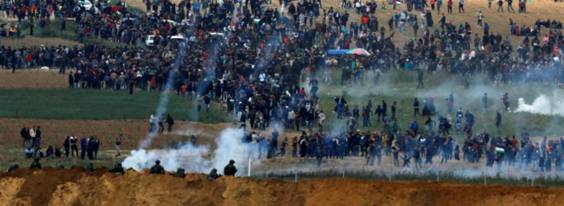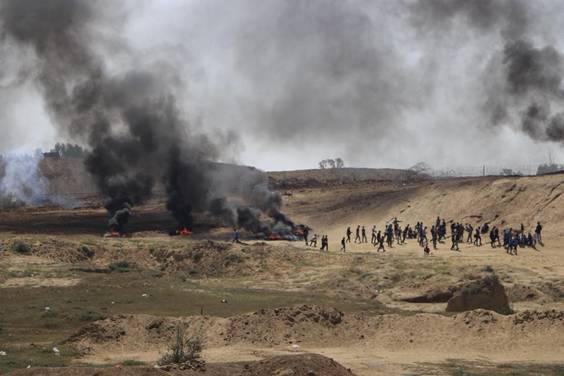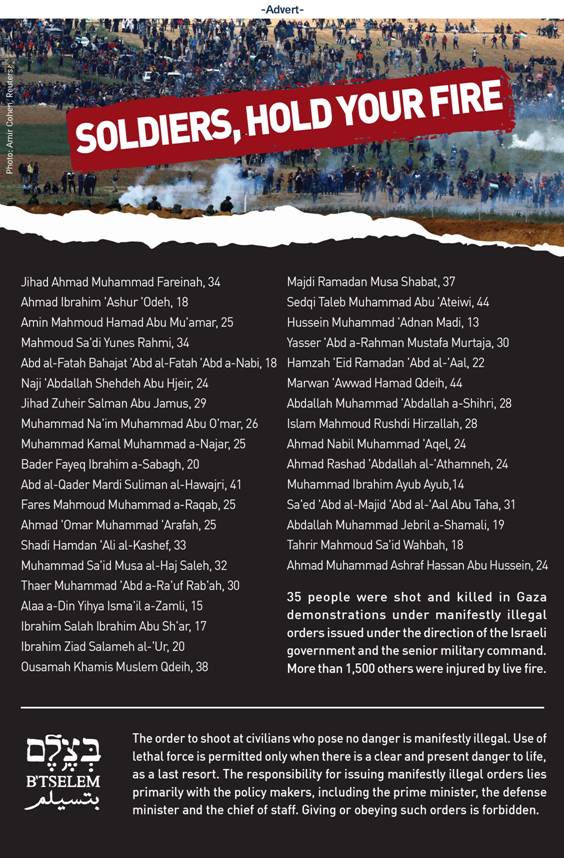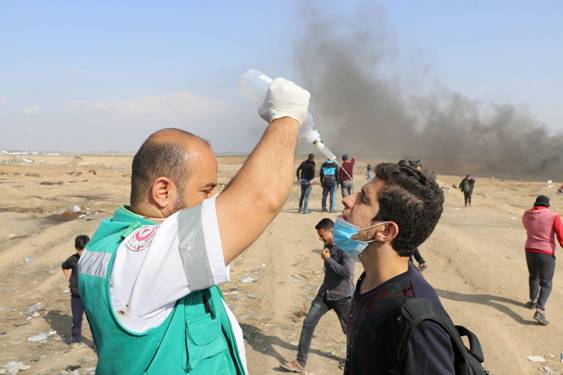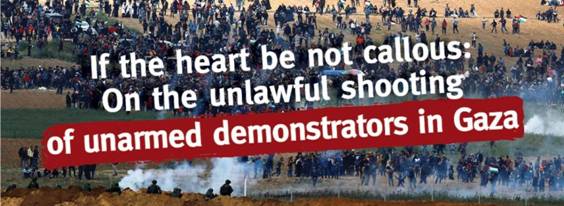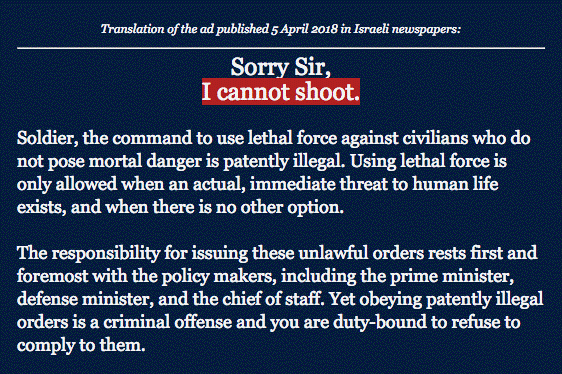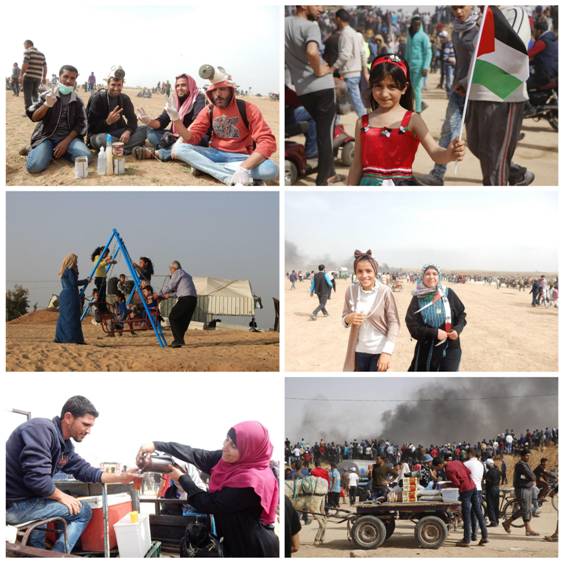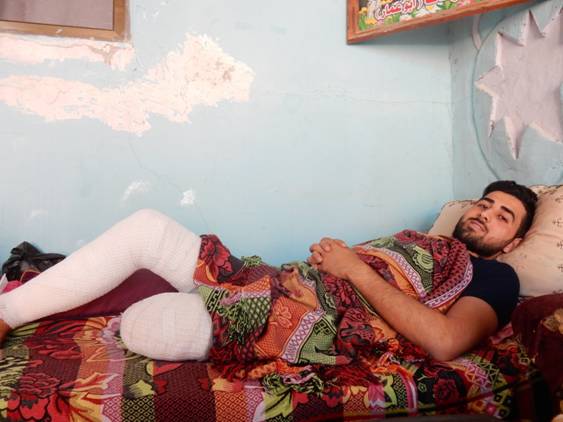|
"I
live in Gaza, and I'm afraid"
|
|
|
Dear
ביאטה,
My name is Olfat al-Kurd. I live in Shuja'iya in Gaza. I am 37 years old and have four
children. In July 2017, I joined the B’Tselem
team as one of three field researchers in Gaza. In the past few weeks,
since the protests along the fence with Israel began, we have been
working around the clock to document, collect eyewitness accounts and
testimonies of injured people, and gather information about
the demonstrations and casualties.
I attend the weekly protests not only in my professional capacity but
also as a Gazan. Some of my photos, posted
on B’Tselem’s
photo
blog
, show how most of the protesters gather in tents
pitched far from the fence. These families enjoy entertainment stages,
live music, food stalls and other family activities. We go there to
convey a political message, to demonstrate, but non-violently – we
don’t go there with weapons. The soldiers shoot at us nonetheless, and
people are injured from live fire and tear gas.
This week, a concerned Israeli colleague asked me why I keep attending
the protests, even though it’s dangerous. I replied that I am, of
course, afraid, sometimes so much that I fear
I won’t come back.
But the truth is that nowhere in Gaza is safe – whether near the
border or in our own homes. Israeli planes can bomb any house,
anywhere, at any moment. We all live in constant dread of something
terrible happening. Everyone in Gaza lost a relative in the last wars.
I lost my brother in the 2009 war.
The festival activities at the protests are a rare opportunity for us
to breathe, meet people, and feel that we belong to something larger
than ourselves. The open areas near the fence are the vastest in Gaza,
but no one has dared go there since the last war. We can’t go to the
beach any longer because sewage infrastructure has collapsed as a
result of the blockade, and raw sewage flows into the sea. Many Gazans live in abject poverty and cannot afford to
sit in a café or a restaurant, so they come to the protests with a
coffee thermos and food.
Israel has been holding Gaza under blockade for more than ten years.
Some of the young people participating in the protests and being
wounded or even killed by soldiers, do not know what it’s like to have
running water and a steady supply of electricity. They have never left
Gaza and grew up in a prison.
You can’t visit us, Israel doesn’t allow
anyone to see what’s going on here. There is no real life in Gaza. The
whole place is clinically dead.
The younger generations are crushed by the hopelessness and death
everywhere. The protests have given us all a spark of hope. They are
our attempt to cry out to the world that it must wake up,
that there are people here fighting for their most basic rights, which
they are entitled to fulfill. We deserve to live, too.
|
|
|
Sincerely,
Olfat al-Kurd
Gaza Field Researcher
B'Tselem
|
|
|
|
We thank the 408 supporters
who donated $52,040 to B'Tselem during March & April 2018. We won't be
able to keep working without your generous support.
A special thanks to the 147 Israelis among them. Together we will stop
the occupation.
|
|
|
|
|
Shooting
unarmed demonstrators is illegal and the command that allows it is
manifestly illegal
Since 30 March 2018, Gazans have protested
along the fence with Israel every Friday, with anywhere between
thousands and tens of thousands of people participating. At least 39
people have been killed by live fire shot by Israeli security forces
and, according to Palestinian Ministry of Health statistics, some 8,000
people have been wounded, more than 2,100 of them from live
rounds.
Israeli security forces have been following manifestly unlawful orders
for a month now, using live fire against unarmed protestors located on
the other side of the fence, posing no danger to anyone. State
officials refuse to change these orders, even in the face of the deaths
and hundreds of injuries they have caused, claiming they are legal and
defending them in court. However, as Justice Benjamin Halevy ruled in
the Kafr Qasem case
back in the 1950s, the illegality of these orders “pains the eye and
outrages the heart, if the eye be not blind
and the heart be not callous or corrupt”. Therefore, these orders must
not be issued and must not be obeyed.
|
|
- B’Tselem to
UN Secretary General: Protect Lives of Palestinian Protestors
Ahead of the UN Security Council's open
debate on April 26th, and as the demonstrations along the Gaza-Israel
fence are expected to continue, B’Tselem
Executive Director Hagai El-Ad sent UN
Secretary-General António Guterres a letter listing the names of the 35
Palestinians protestors shot to death (to that date)
by Israeli forces during these demonstrations, four of whom were
minors. El-Ad called upon the UN to do “all that is in its power – and
its responsibility – in order to protect Palestinian lives and uphold
international norms”, with the goal of immediately ending the illegal
shooting of unarmed demonstrators in Gaza.
|
|
|
On April
26th B'Tselem published the names of
protestors shot and killed in Gaza demonstrations under manifestly
illegal orders. The order to shoot at
civilians who pose no danger to anyone is manifestly illegal.
Use of lethal force is permitted only when there is a clear and
present danger to life, as a last resort. The responsibility for
issuing manifestly illegal orders lies primarily with the policy
makers, including the prime minister, the defense minister and the
chief of staff. It is forbidden to give and to obey such
orders. Over 1,500 people have been injured by live
fire.
|
|
- Israeli
military fired teargas at family tents far from fence during Gaza
protests, injuring hundreds
B’Tselem’s
investigation has found that soldiers fired teargas at men, women and children engaged in
peaceful activities in tents pitched hundreds of meters from the fence
during the recent Gaza protests. This is neither lawful nor justified:
Israel has no right to disperse demonstrations inside Gaza or tell Gazans where they can be. It certainly may not fire
teargas at demonstrators hundreds of meters from the fence who pose no
threat to a soul.
|
|
|
If the heart be not callous: New position paper by B’Tselem on the unlawful shooting of unarmed
demonstrators in Gaza. Despite
the heavy toll on life and limb of Gazan
protesters, all state and military officials refuse to cancel these
manifestly unlawful open-fire orders and continue to issue – and
justify – them. On 13 April 2018, B’Tselem
issued a position paper on its
findings regarding the first day of protest, analyzing the illegality
of orders to shoot at unarmed demonstrators who pose no danger to
anyone.
|
|
|
On 5 April 2018, B'Tselem launched a campaign entitled “Sorry
sir, I cannot shoot." in the Israeli media. The campaign
included newspaper advertisements clarifying to Israeli soldiers
that they must refuse to open fire on unarmed demonstrators. The
organization is taking this unusual step following March
30th's events when soldiers used live fire against unarmed
demonstrators.
|
|
- Photo Blog: Gaza not through gun
sights
In recent weeks, tens of thousands of Gazans have protested along the fence with
Israel. Most have stayed several hundred meters away from the fence,
with the demonstrations taking the form of a folk festival:
entertainment stages, live music, food stalls and large tents where
entire families spend the day.
Naturally, media coverage and public debate have
focused on Israeli soldiers shooting demonstrators who approached the
fence. Yet it is worth pausing over the vast majority of protesters,
who have not been involved in such incidents. B’Tselem
field researcher Olfat al-Kurd, Muhammad
Sabah and Khaled al-‘Azayzeh
documented not only casualties, but also the back line of the
demonstrations: teens playing soccer, women baking bread, food stalls,
and Gazans asking for an end to the Israeli
blockade that has made their lives intolerable.
|
|
|
- Failing Gaza healthcare system after
10-year blockade barely handling 2,000+ live fire injuries
Since 30 March 2018, more than 2,000
Palestinians have been injured by Israeli live fire at protests near
the Gaza fence. Doctors there report unusually severe injuries and the
healthcare system, already failing after a decade of Israeli blockade, cannot provide proper care. Rehabilitation options are also few and too expensive for most. Israel
is responsible for this state of affairs: it ordered the unlawful
shooting, brought the Gazan healthcare system
to the verge of collapse and is denying the wounded rehabilitation – in
or out of Gaza.
|
|
|
B'Tselem in the
media - Gaza
|
|
|
|
|
|



